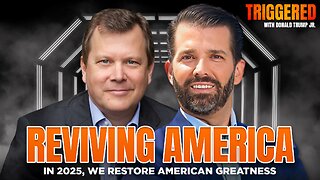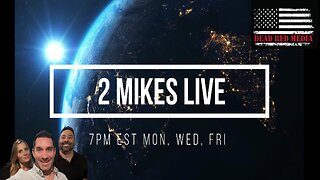Premium Only Content

If the System Collapsed, What Would Happen to My Money? | The Gold Standard 2432
https://www.midasgoldgroup.com/
Jennifer Horn is joined by Ken Russo for a critical discussion on a question that weighs heavily on many minds: “If the System Collapsed, What Would Happen to My Money?” As they explore the potential consequences of software glitches, stock market crashes, and economic instability, Ken offers insights on safeguarding your savings and investments from the looming abyss. But to understand the full scope of our financial vulnerability, we must revisit that fateful day in April 1971 when President Nixon took the United States off the gold standard—a decision that reshaped the financial landscape forever. This move, intended as a temporary measure, fundamentally altered the financial landscape, leading to the unbridled printing of money and the detachment of the dollar from tangible assets.
The Hidden Cost of Inflation: A Warning from Robert Kennedy, Jr.
In a powerful statement at a recent conference, Robert Kennedy, Jr. shed light on the long-term consequences of President Nixon’s decision to take the United States off the gold standard in 1971. Quoting Kennedy, Ken Russo emphasizes how this move, initially intended to finance the Vietnam War, has led to a relentless decline in the dollar’s purchasing power. Russo shares Kennedy’s chilling insight: “Alan Greenspan, who was chairman of the Federal Reserve for 20 years, warned that without a gold standard, there is no way to protect savings from confiscation through inflation.”
The Growing Mountain: A History of Our National Debt
The U.S. national debt has become an ever-expanding burden, now standing at a staggering $35.3 trillion (that’s the official debt, the accurate amount is several times that), equivalent to roughly $94,000 for every American citizen. This debt, fueled by continuous budget deficits where government spending exceeds revenue, has doubled nearly every decade since the 1980s. The seeds of this crisis were sown long ago, but the most significant turning point came when President Nixon took the country off the gold standard in 1971 to finance the Vietnam War. Since then, the ability to print money without the backing of tangible assets has led to unchecked government borrowing, contributing to a debt that grows larger with each passing year. The implications of this massive debt are far-reaching, with a significant portion of the federal budget now dedicated to servicing the interest alone.
When and If the System Collapses
If the U.S. dollar were ever to collapse, the consequences would be devastating, not just for the American economy but for the global financial system. The cost of imports would skyrocket, as the weakened dollar would have significantly less purchasing power. The government, unable to borrow at current rates, would face a ballooning deficit that could only be addressed through drastic measures, such as raising taxes or printing more money—both of which could further destabilize the economy. Historically, a currency collapse has often been triggered by political or economic turmoil, hyperinflation, or war, leading to a situation where the currency becomes practically worthless.
While the likelihood of the U.S. dollar collapsing is low, thanks to its status as the world’s reserve currency and the strength of the U.S. economy, it’s not entirely impossible. It could fundamentally alter daily life as we know it.
The Devastating Impact of Hyperinflation
Hyperinflation is a severe economic event where a currency loses its value rapidly, over 50% per month, leading to widespread economic and social chaos. While the U.S. has not experienced hyperinflation, recent inflationary pressures and rising national debt raise concerns. History shows us how quickly hyperinflation can devastate an economy, as seen in Lebanon, Zimbabwe, and Venezuela, where currencies became nearly worthless, leading to civil unrest and poverty. With the U.S. facing similar economic challenges, the risk of a currency devaluation crisis is real.
Gold & Silver Protection
Gold and silver have long been trusted as havens during times of economic and geopolitical uncertainty and instability. Unlike paper currencies, which, as we’ve seen, can be devalued through inflation and monetary policy, precious metals retain intrinsic value due to their scarcity and universal acceptance. Throughout history, when governments and financial systems have faltered, gold and silver have consistently maintained their purchasing power, offering stability and security. In unpredictable times, these metals serve as reliable stores of value, providing a financial anchor in a sea of uncertainty. As traditional currencies face growing risks, including potential devaluation, gold and silver stand out as proven assets that protect wealth and ensure financial resilience.
______________________________________________________________________________________________
Listen to The Gold Standard: https://www.midasgoldgroup.com/gold-standard-radio-show/
Gold IRA: https://www.midasgoldgroup.com/gold-ira/
Invest in Gold: https://www.midasgoldgroup.com/buy-gold/
Guide to Owning Bullion & Coins: https://www.midasgoldgroup.com/bullion-guide/
Read the latest precious metals news: https://www.midasgoldgroup.com/news/
-
 25:04
25:04
Midas Gold Group
4 months agoInflation Busters | The Gold Standard 2434
26 -
 2:11:02
2:11:02
Kim Iversen
10 hours agoMUSK VS MAGA: Are Americans Too Uneducated and Lazy To Hire? | Debate: “Jesus Wasn’t A Jew”
73.1K241 -
 5:25:14
5:25:14
Drew Hernandez
7 hours agoMAGA CIVIL WAR OVER H-1B & DREW W/ HODGE TWINS
64.1K72 -
 1:05:22
1:05:22
Donald Trump Jr.
12 hours agoAmerica First Means Reviving the American Dream, Interview with Peter Schweizer | TRIGGERED Ep.203
137K283 -
 1:34:02
1:34:02
The Officer Tatum
12 hours agoLIVE: Trump ENDORSES Mike Johnson as Elon BACKTRACKS On H-1B + MORE | Officer Tatum Show EP 32
95.3K127 -
 45:56
45:56
Kimberly Guilfoyle
12 hours agoNew Year. Same MAGA Mission, Live with Roger Stone | Ep. 183
103K41 -
 1:49:14
1:49:14
2 MIKES LIVE
16 hours ago2 MIKES LIVE #160 We're Back! Deep Dive Monday!
70.5K13 -
 54:28
54:28
LFA TV
1 day agoTrump’s Triumphant Year | Trumpet Daily 12.30.24 7PM EST
69.8K11 -
 2:28:37
2:28:37
Quite Frankly
14 hours ago"2024 Review, Homunculus Flu, Old/New Year Predictions" 12/30/24
92.2K15 -
 14:04:17
14:04:17
RonjnJeremy
17 hours ago $9.05 earnedClassic Wow 20th Anniversary edition HC SF, Rogue..PT8 lvl 46+ Just need to stay alive...
113K6